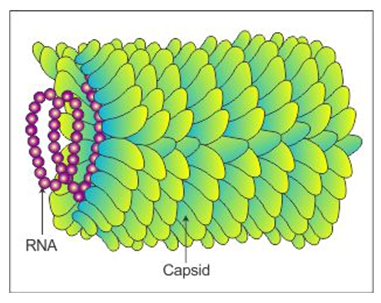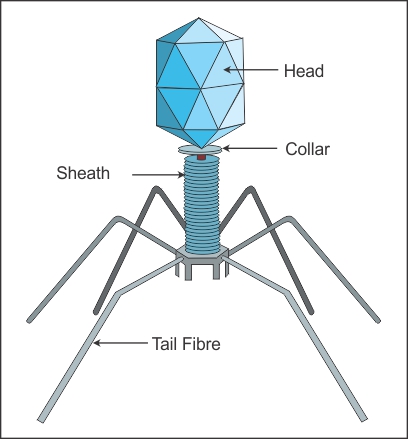
Viruses, Viroids, AND Lichens
In the five kingdom classification of Whittaker, there is no mention of some acellular organisms like viruses and viroids, and lichens.
Viruses:

Viruses are non-cellular organisms that are characterized by having an inert crystalline structure outside the living cell.
Once they infect a cell they take over the machinery of the host cell to replicate themselves, killing the host.
The name virus (venom or poisonous fluid) was given by Pasteur. D.J. Ivanowsky.
The Tobacco Mosaic Virus was found to be smaller than bacteria because they passed through bacteria-proof filters.
M.W. Beijerinek demonstrated that the extract of the infected plants of tobacco could cause infection in healthy plants and is called the fluid Contagium vivum fluidum.
W.M. Stanley showed that viruses could be crystallized and crystals consist largely of proteins****.
They are inert outside their specific host cell.
They are obligate parasites.
Viruses also contain genetic material, that could be either RNA or DNA but never both.
Viruses are nucleoproteins and the genetic material is infectious.
Viruses that infect plants have single-stranded RNA and viruses that infect animals have either single or double-stranded RNA or double-stranded DNA.
Bacterial viruses or bacteriophages (viruses that infect bacteria) are usually double-stranded DNA viruses.

The protein coat called capsid made of small subunits called capsomeres protects the nucleic acid.
These capsomeres are arranged in helical or polyhedral geometric forms.
Viruses cause diseases like mumps, smallpox, herpes, AIDS, and influenza.
In plants, the symptoms can be:
The mosaic formation
leaf rolling and curling
yellowing and vein clearing
dwarfing
stunted growth.
Viroids:
T.O. Diener discovered a new infectious agent that was smaller than viruses and caused potato spindle tuber disease.
It was found to be a free RNA.
It lacked the protein coat that is found in viruses.
The RNA of the viroid was of low molecular weight.
Lichens:
They are symbiotic associations i.e. mutually useful associations, between algae and fungi.
The algal component is known as phycobiont and the fungal component is mycobiont, which is autotrophic and heterotrophic, respectively.
Algae prepare food for fungi and fungi provide shelter and absorb mineral nutrients and water for their partner.
Lichens are very good pollution indicators – they do not grow in polluted areas.
Viruses, Viroids, AND Lichens
In the five kingdom classification of Whittaker, there is no mention of some acellular organisms like viruses and viroids, and lichens.
Viruses:

Viruses are non-cellular organisms that are characterized by having an inert crystalline structure outside the living cell.
Once they infect a cell they take over the machinery of the host cell to replicate themselves, killing the host.
The name virus (venom or poisonous fluid) was given by Pasteur. D.J. Ivanowsky.
The Tobacco Mosaic Virus was found to be smaller than bacteria because they passed through bacteria-proof filters.
M.W. Beijerinek demonstrated that the extract of the infected plants of tobacco could cause infection in healthy plants and is called the fluid Contagium vivum fluidum.
W.M. Stanley showed that viruses could be crystallized and crystals consist largely of proteins****.
They are inert outside their specific host cell.
They are obligate parasites.
Viruses also contain genetic material, that could be either RNA or DNA but never both.
Viruses are nucleoproteins and the genetic material is infectious.
Viruses that infect plants have single-stranded RNA and viruses that infect animals have either single or double-stranded RNA or double-stranded DNA.
Bacterial viruses or bacteriophages (viruses that infect bacteria) are usually double-stranded DNA viruses.

The protein coat called capsid made of small subunits called capsomeres protects the nucleic acid.
These capsomeres are arranged in helical or polyhedral geometric forms.
Viruses cause diseases like mumps, smallpox, herpes, AIDS, and influenza.
In plants, the symptoms can be:
The mosaic formation
leaf rolling and curling
yellowing and vein clearing
dwarfing
stunted growth.
Viroids:
T.O. Diener discovered a new infectious agent that was smaller than viruses and caused potato spindle tuber disease.
It was found to be a free RNA.
It lacked the protein coat that is found in viruses.
The RNA of the viroid was of low molecular weight.
Lichens:
They are symbiotic associations i.e. mutually useful associations, between algae and fungi.
The algal component is known as phycobiont and the fungal component is mycobiont, which is autotrophic and heterotrophic, respectively.
Algae prepare food for fungi and fungi provide shelter and absorb mineral nutrients and water for their partner.
Lichens are very good pollution indicators – they do not grow in polluted areas.
 Knowt
Knowt
